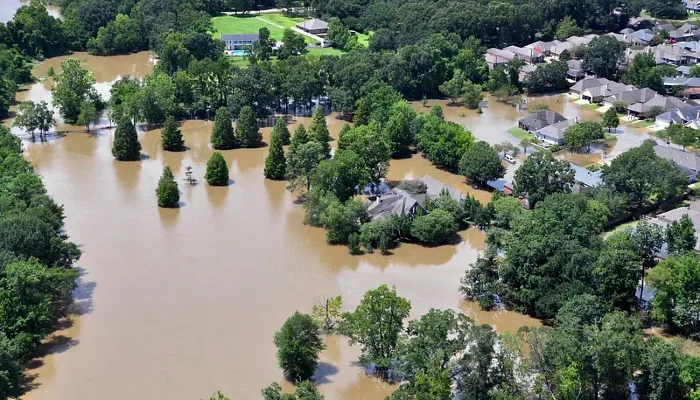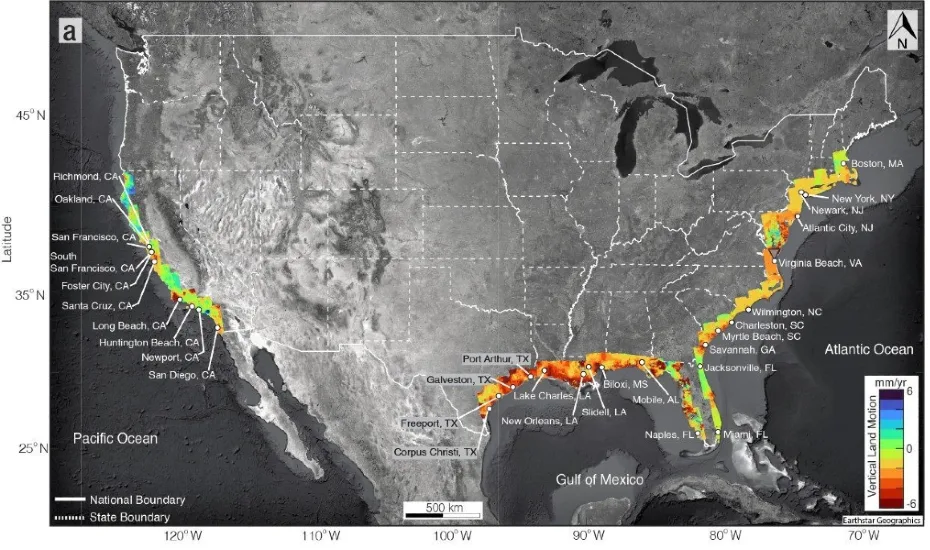An eye-opening, and horrifying, study from Virginia Tech has unveiled a pressing issue for coastal cities across the United States. By 2050, one in every 50 residents in 24 coastal cities could be grappling with flooding, not just from rising sea levels but from the land itself sinking beneath them. This phenomenon, known as land subsidence, combined with the encroaching sea, spells a more immediate danger than previously thought.
Leonard Ohenhen, the study’s lead author, emphasizes the critical role of land subsidence in the climate change narrative, a factor often overlooked in discussions focused solely on rising sea levels. “One of the things we wanted to do with this study is really emphasize the impact of land subsidence, which is often not reflected in most of the discussion around sea level rise,” Ohenhen states, highlighting the study’s aim to bring attention to this underrepresented issue.
A Closer Look Through Satellite Eyes
Employing advanced satellite technology, the researchers measured how much the land in 32 cities across the Atlantic, Pacific, and Gulf coasts is sinking. These satellites, by timing how long their signals take to bounce back from Earth, reveal whether the ground is rising or falling. The findings are stark: 24 of these cities are sinking over 2 millimeters annually, with several areas subsiding quicker than global sea levels rise.
This sinking poses a real risk to up to 500,000 people and could affect one in every 35 properties in the coming three decades, demonstrating the urgency of addressing this issue sooner rather than later.

Short-Term Hazards and Long-Term Impacts
The focus on the distant future in climate change discussions often leads to a lack of preparation for imminent threats. “We tend to think of the consequences of climate change as a long-term effect,” Ohenhen notes.
“Which makes people feel like you cannot really account for all of the changes or the things that will happen before that time. And that often leads to under preparation,” Ohenhen continued, advocating for a shift in perspective to recognize and act upon the dangers already at our doorstep.
Robert Nicholls, echoing this sentiment, points to the year 2050 not as a distant benchmark but as an imminent milestone demanding immediate action. This sentiment is underscored by the disproportionate impact on communities of color, particularly in the Gulf Coast region, where minorities, expected to bear the brunt of flooding, represent a significant portion of the population at risk.
Cities on the Brink: The 32 Most At-Risk Coastal Communities
Based on the study findings using satellite data, these are the cities across the United States that will be most impacted by sinking coastal lands and exacerbated flooding due to sea level rise. These cities span the Atlantic, Gulf, and Pacific coasts:
US Atlantic Coast
- Boston, MA
- New York City, NY
- Jersey City, NJ
- Atlantic City, NJ
- Virginia Beach, VA
- Wilmington, NC
- Myrtle Beach, SC
- Charleston, SC
- Savannah, GA
- Jacksonville, FL
- Miami, FL
US Gulf Coast
- Naples, FL
- Mobile, AL
- Biloxi, MS
- New Orleans, LA
- Slidell, LA
- Lake Charles, LA
- Port Arthur, TX
- Texas City, TX
- Galveston, TX
- Freeport, TX
- Corpus Christi, TX
US Pacific Coast
- Richmond, CA
- Oakland, CA
- San Francisco, CA
- South San Francisco, CA
- Foster City, CA
- Santa Cruz, CA
- Long Beach, CA
- Huntington Beach, CA
- Newport Beach, CA
- San Diego, CA
These cities are experiencing subsidence rates greater than 2 mm per year, with notable cases where the subsidence rates exceed 5 mm per year in cities such as Charleston (SC), Biloxi (MS), Galveston (TX), and Corpus Christi (TX).
The Path Forward: Recognition and Adaptation
The study serves as a clarion call for acknowledgment and action. “It’s really a wake-up call to think about how we’re going to live with this changing interface between the land and the sea,” Nicholls reflects, suggesting that the journey to mitigation begins with recognizing the problem.
Adaptation strategies, from engineering feats like protective walls and elevated structures to natural defenses like marshes and coral reefs, are highlighted as vital components of a multifaceted approach to staving off the worst effects of sea level rise and land subsidence. Siddharth Narayan and Andra Garner both advocate for a blend of structural and natural solutions to create buffers against the encroaching seas.
“So it’s going to be a combination of long-term structural adaptations and solutions wherever possible and conserving and maintaining our natural spaces to add a little bit of a buffer,” Narayan said.
The Future of Flooding: Planning and Uncertainty
Garner, drawing on her research, warns of the uncertainties ahead, exacerbated by human actions and inactions. Her work points to a widespread underestimation of sea level rise projections, emphasizing the need for at-risk communities to leverage available tools and work toward viable solutions.
More To Discover
- Oil and Corn Giants Unite in Unlikely, And Unnecessary, Alliance Against Electric Cars
- From High Hopes to Bankruptcy: The Rise and Fall of Braddock’s Vertical Farming Pioneer, Fifth Season (Our Analysis Included)
- JBS’s Greenwashing Charges As NY Demands Accountability For Company With Italy-Sized Emissions
- U.S. Bets Big on Small Innovative Reactors for Nuclear Comeback
Key Takeaways:
- A Virginia Tech study reveals an imminent flooding risk in 24 US coastal cities by 2050 due to land subsidence and rising sea levels.
- Up to 500,000 individuals and one in every 35 properties could face flooding, with communities of color disproportionately affected.
- The research combines satellite measurements with sea level and tide data for a comprehensive risk projection.
- Recognition of the problem and a combination of structural and natural adaptation strategies are essential steps forward.
- The study calls for immediate action and planning to mitigate the impacts of sea level rise and land subsidence on vulnerable communities.
Source: Nature




















